- Prelude
- Editorial
- Subodh's 'return home'
- A Conversation with TV Santosh
- It's a War Out There
- Raqib Shaw
- Illusions in Red from a very British Indian Sculptor
- Stand Alone: Shibu Natesan
- Reading Atul Dodiya
- Bharti Kher: An Obsession for Bindis
- Bose Krishnamachari
- The Image - Spectacle and the Self
- From Self-depiction to Self-reference: Contemporary Indian Art
- GenNext: The Epitome of New Generation Art
- Kolkata's Contemporary Art A Look in the Mirror
- Innovation Coalesced with Continuing Chinese Qualities
- Kala Bhavana-Charukala Anushad Exchange Program
- Montblanc Fountain Pens
- Dutch Designs: The Queen Anne Style
- Bangalore Dance Beat
- Decade of change
- Distance Between Art & It's Connoisseur
- What Happened and What's Forthcoming
- 3rd India Art Summit
- New Paradigms of the Global Language of Art
- Black Brown & The Blue: Shuvaprasanna
- Art Events Kolkata
- Musings from Chennai
- Art Bengaluru
- Printmaker's Season
- Mumbai Art Sighting
- The Pause of Profound Stillness
- Previews
- In the News
- The Rebel Queen: An icon of her own times yet looked down upon
ART news & views
3rd India Art Summit
Volume: 3 Issue No: 14 Month: 3 Year: 2011
India Art Summit
by Nanak Ganguly
When Neha Kripal wrote the initial business plan for the Indian Art Summit on the back of an airplane sickness bag, on flight from Bombay to Delhi, she never imagined the Summit would be as big as this. 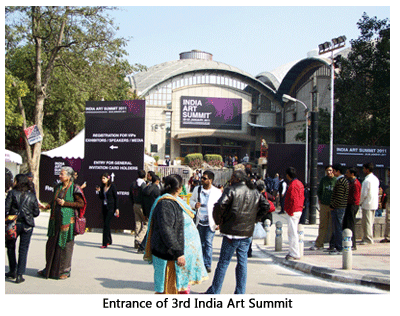 There were more than one lakh of visitors during those three days in January and surpassed her estimates much to her delight.
There were more than one lakh of visitors during those three days in January and surpassed her estimates much to her delight.
On the opening day she announced “we have 84 participating galleries, out of which 34 are international, as compared to 54 participating galleries in 2009. There are about 19museum delegations, and about 20 countries which are participating this time. Everything has doubled this time than the last year. We have 400-500 souvenirs people can take with them on the last day, which is January 23.” With over 130,000 people turning up over the three days and 'sold' stickers popping up at galleries, first time buyers rubbed shoulders with big time collectors that indicated a trend that the market is growing. There was everything from Picasso, Dali to Husains guarded almost by the entire Delhi Police. German galleries Beck & Eggeling and Die both sold a Picasso for over 20 lakhs each. Lesser known British artists Isabel Rock and Alec Cummings represented by UK based gallery Art 18-21 had a field day in Summit in terms of sale. The international demand for the Masters has diminished and this shows a trend. The foreign galleries are probably here to fill an expanding market. A friend picked up a sculpture of Alain Clément from Galerie Baudoin Lebon, Paris and Anish Kapoor's iconic mirror was collected on the last day at Lisson Gallery's booth. In fact Kapoor's first full exhibition brought to India by the Gallery Lisson with collaboration of British Council and NGMA was on view at the NGMA during the Summit and is still on when this goes to print. In fact Kirpal expects apart from the international and leading Indian galleries, more and more dealers from smaller, Tier II towns like Bilaspur, Surat and Srinagar in the coming years. 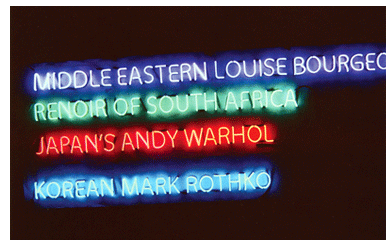 Interestingly Renu Modi of Gallery Espace had queries from a dealer based in Rio de Janeiro. At a time when the much awaited Triennale to be conducted under the aegis of Lalit Kala Akademi and Delhi Biennale pushed by the likes of Vivan Sundaram or Sheba Chachi are still facing an uncertain fate, the present Summit, at this scale, certainly provides a fillip in the market infrastructure during its moment of anorexic growth.
Interestingly Renu Modi of Gallery Espace had queries from a dealer based in Rio de Janeiro. At a time when the much awaited Triennale to be conducted under the aegis of Lalit Kala Akademi and Delhi Biennale pushed by the likes of Vivan Sundaram or Sheba Chachi are still facing an uncertain fate, the present Summit, at this scale, certainly provides a fillip in the market infrastructure during its moment of anorexic growth.
There were about 19 parallel events taking place all over the city. The speaker's forum had 12 seminar sessions and 40 speakers. It had conversation series with cultural theorists like Homi Bhabha, curator Hans-Ulrich Obrist, Anish Kapoor, Jyotindra Jain, Geeta Kapoor, bureaucrat Jawahar Sircar, and Lalit Kala chairman Ashok Vajpeyi and others. A moonlit walk through the nukkads of Lado Sarai to have a peek at an artist's studio or a private gallery took place. A book on Calcutta based artist Shuvaprasanna was also launched. To hear Bhabha, who was the star speaker at the Summit was an experience. Presently he is Anne Rothenberg Professor of Humanities and Director of the Humanities Centre at the Harvard University. Like his all his written texts, his oratory is a dazzlingly virtuoso performance. In the teeth of all speakers forum, as one may love to name it, Bhabha is a sabre rattling polemicist who enjoys conflict and likes to win and which he recommends fits rather better with being the Professor of a US university than it does with being a sixth century Scottish hermit. A scholar who has written with incredible élan about metropolitan and diasporic literatures, contemporary art and his range is diverse from Forster, Conrad to Gordimer and Morrison. He has revisited premises like colonial mimicry, hybridity and social liminality to argue that cultural production is always most productive where it most ambivalent and transgressive. A post colonial critic, who can write with great theoretical brilliance, his language lurching as it does from the high toned to the streetwise, belongs to a culture where there is 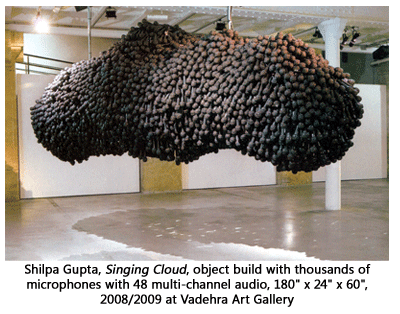 less middle ground between portentous and homespun; he is reluctant to be left out of any theoretical game in town.
less middle ground between portentous and homespun; he is reluctant to be left out of any theoretical game in town.
Some of the approach to curatorship today is ambiguous and especially at the summit the respective booths display works what they mostly deal with at present. The works are mostly representational of the dealers which includes Grosvenor from London, Galerie Krizinger or Galerie Boudain Lebon from Paris,Flo Peters Gallery, Hamburg, Galerie Christian Hosp, Berlin, Matthieu Foss Gallery, Mumbai, Gallery Lemongrasshopper, Ahmedabad, Sundaram Tagore Gallery, New York/Hong Kong and others. A rejection of an escapism and distance, the total installation, which is quasi-curatorial approach, is a complete experience that disallows curatorial mediation by turning the entire structure of the installation into the artist's product. Leila Pazooki's neon installation merges the role of artist and curator.
As we zip in and zip out various booths; works within a variety of formats and media, and rarely in traditional modes of artistic expression come into view. Often these works are ephemeral in nature, and can sometimes be understood as events. There are playful, fanciful and times.
As we zip in and zip out various booths; works within a variety of formats and media, and rarely in traditional modes of artistic expression come into view. Often these works are ephemeral in nature, and can sometimes be understood as events. There are playful, fanciful and times robust kind of enquiry in these experiments for example Anjum Singh's Spill at Palette or Shilpa Gupta's Singing Cloud at Vadehra, which comes from a desire for a language to shake up our everyday lives, rituals, and social constrictions. Play a lot to aesthetics, they are not devoid of political import.
Shilpa Gupta is the analyst of her own identity. Neither Shilpa's aspirations are to make a meditated simulacrum of the politics of desire but to approach as near to the reality of that desire as possible, to be in a complex and full way, realistic not to be restricted by any debased modernism. 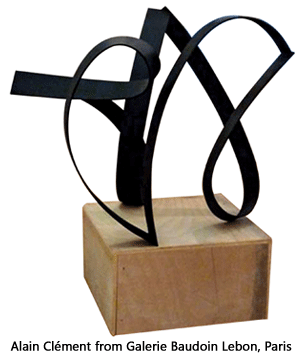 There are many constants in these works, wherever its site or performance, those are indicative of their structural concerns and their expressive concerns. Its structure is made visible by lines and notational markings across a floor extending to the walls surrounding us.
There are many constants in these works, wherever its site or performance, those are indicative of their structural concerns and their expressive concerns. Its structure is made visible by lines and notational markings across a floor extending to the walls surrounding us.
But the mere image of say, a computer or video cannot act in the same way with respect an advanced technological capability which is electronic rather then mechanical. These new gadgets are not simply the products of a particular society but are themselves the means by which that society reproduces itself. The form bears itself no relation to their content. It is only through the process of their functioning that they are able to represent the world, and when they do not function they are nothing. Time-based work is about something more than the reference of events to the passing moments, it is the involvement with a culture which can only be adequately represented through these passing moments dwelling on the characters, messages, and vicissitudes of physical and emotional reality inherent in the very definition of what real is; that of which it is possible to give an equivalent reproduction. The real is not only that which can be reproduced, but which is always already reproduced. That was the time of cable revolution when the Iraq war broke. The coverage of the war entered into our drawing rooms through TV's latest avatar- the CNN-Fox. Above all it was a matter of the collapse of reality into hyperrealism, into a painstaking reduplication of the real war into any American war saga. In preference to starting out from some other medium, be it reproductive, publicity, photographic; from medium to medium the real war volatilized, it became an allegory of death, a new mega serial but it also reinforced itself by its own destruction, it became a proxy for the real, a fetishism of the lost object, no longer the object of representation, but an ecstasy of denial and of its own ritual extermination: the hyperreal.
While we straddle from one space to the other from Threshold Art Gallery, Project 88, Tao Art Gallery, Wonderwall, Sanskrit Art Gallery, Aakar Prakar, Kolkata to Grey Noise, Lahore we realize that throughout these works there is challenge, both in its formal construction and in the themes these artists tackle. That of the artist's struggle with inhibitions, contradictions, disillusionment, political and personal isolation.
The present process of making the process as the spectator takes a look in the sculpture park- the continual erasing of memory and reconstruction and reworking of material is a reflection of an erasure that reflects our spoilt ad scarred landscape- Sudarshan Shetty's or Gigi Scaria's installations.  Each new step, each new possibility retreats into old solutions and is discarded. But it would be impossible to stop- one has to create the text in spite of the odds. It confronts our traditional experience of sound, of light, of setting-these are wrenched out of context, re-ordered and returned to a new, subtle questioning role of reflecting the artist's choice of subject. Perhaps it is already time for a moratorium on things; a temporary withdrawal from real objects during which the object analogue formed in consciousness may be examined as the origin of a new generating system. A recurrent issue in the new media most often is the plight of the individual in a highly technological world. However, these works are ultimately optimistic although bristling with images of war, aggression, confrontation, displacement, there is a sense, achieved through ironic focus, beyond that lies something more hopeful but first it is necessary to overturn what we have and create the neutral space from which new things shall grow. A decade back artists began to combine image and text and over the last decade, these works have increased in subtlety and in the interplay of meanings. Today's new media artist opposes what he calls the old-fashioned “logocentric” Renaissance view of painting's “presence” with an art whose new apparatus include the notion of the institution and which uses today's primary means of communication, photography, video, cinema, television. The use of the despised medium, and a critique of the means of production led this practitioners to cast conceptual art as gesture not of denial but of opening up of the institution of art to the world outside, letting other disciplines. These include linguistics, semiological analysis, political theory and above all psychoanalysis.
Each new step, each new possibility retreats into old solutions and is discarded. But it would be impossible to stop- one has to create the text in spite of the odds. It confronts our traditional experience of sound, of light, of setting-these are wrenched out of context, re-ordered and returned to a new, subtle questioning role of reflecting the artist's choice of subject. Perhaps it is already time for a moratorium on things; a temporary withdrawal from real objects during which the object analogue formed in consciousness may be examined as the origin of a new generating system. A recurrent issue in the new media most often is the plight of the individual in a highly technological world. However, these works are ultimately optimistic although bristling with images of war, aggression, confrontation, displacement, there is a sense, achieved through ironic focus, beyond that lies something more hopeful but first it is necessary to overturn what we have and create the neutral space from which new things shall grow. A decade back artists began to combine image and text and over the last decade, these works have increased in subtlety and in the interplay of meanings. Today's new media artist opposes what he calls the old-fashioned “logocentric” Renaissance view of painting's “presence” with an art whose new apparatus include the notion of the institution and which uses today's primary means of communication, photography, video, cinema, television. The use of the despised medium, and a critique of the means of production led this practitioners to cast conceptual art as gesture not of denial but of opening up of the institution of art to the world outside, letting other disciplines. These include linguistics, semiological analysis, political theory and above all psychoanalysis.
The signified and referent are now absorbed in Ranbir Kaleka's video installations at the Volte Gallery booth to the sole profit of the play of signifiers, of a generalized formalization where the code no longer refers back to any subjective or objective reality, but to its own logic. All reality then becomes the place of semiological manipulation, of a structural simulation in Kaleka's work. He was a good man, a single channel video projection with sound and painting-acrylic on canvas. There is no objective presence to the world. The world is signed into existence not by reference to the real but to a code; at this point one is left to engage in acts of consumption which shows is no longer really there. We expect the attempts/practices by with some memorable of images of our living and an artist's responses to simulacra. Using a variety of media these artists work from a distinct perspective and sometimes with an explicit feminist agenda, through the panoply of increasingly complex means, including elaborate and large scale installations.
New media artists like Hiroshi Senju (Sundaram Gallery) or Hidemasa Fujii (Tamura Akio Gallery, Tokyo) have always seen their practice as an attempt to make changes in the perception of the social and cultural future through their interaction with the audience. These new media artists set out to create an artwork that will instigate in the audience perceptions, understandings of their own creative potential.
In Gyan Panchal at Galerie Frank Elbaz or Raha Rastifard at Exhibit 320 the logic of the process whereby the fixity of art object is challenged is seen in the increasing degree to which exchange value takes precedence over the use value. And if we take into consideration the knowledge, in the sense that art might provoke one to an understanding that a video monitor could provide us with must be characterized in Gautam Kansara at Shrine Empire Gallery, New Delhi; work more as information/archive, the means to something other than 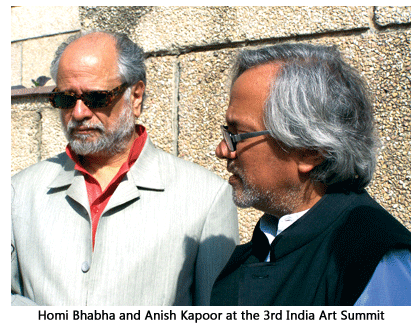 the end in itself that is the performance. Art addresses the physiognomy of power: autonomy has ceased to operate as a paradigm because the space in which art functions has dispersed itself within the social fabric. There is no longer a separate realm capable of acting as a container for the ideal solutions to real problems, no longer a safe distance between the dirt of day to day actions and the purity which surrounds ones hopes and aspirations. The two spheres have merged into one complex hyperspace which is as yet incompletely mapped onto our consciousness.
the end in itself that is the performance. Art addresses the physiognomy of power: autonomy has ceased to operate as a paradigm because the space in which art functions has dispersed itself within the social fabric. There is no longer a separate realm capable of acting as a container for the ideal solutions to real problems, no longer a safe distance between the dirt of day to day actions and the purity which surrounds ones hopes and aspirations. The two spheres have merged into one complex hyperspace which is as yet incompletely mapped onto our consciousness.
Remember the crowd gathered at the site of fire of the city's memorable building a few months back taking photo on their mobile phones to capture the spectacle of fire and death? They compete with each other with their priced acquisitions. Even the expensive cell phones never exhaust themselves in the function they serve, and in this excess of presence they take on their significance of prestige- they no longer designate the world but signify the social rank of the possessor.
The legacy of time-based activity in contemporary practice which brings thoughtful and critical interest is to bear of cultural significance as in Uganda born; Singapore based Ketna Patel in Indigo Blue Art Gallery, Singapore. For the gallery it was a solo project. “With this alternate gaze comes the ability for a different level of 'story telling' through their art” says Suman Agarwal, Director, Indigo Blue Art as she explains the reason for bringing a diasporic artist of Indian origin's work back to India. It should be seen in a positive light, though the confrontations have produced a body of serious work which offers a serious critique, and in case where it seems that content, treatment and the crucial question of narrative that of Nation and Narration, that is process have retreated before an oppositional stance which makes production values alone, what is at first sight, for example, might appear as unwatchable can be seen on reflection as a refusal to succumb to the grand illusion. Many of the works like Asian Grandfathers done in acrylic screenprint are to be understood to be extensions of psychic space, lying somewhere between abstraction and passion and cultural identity.
These popular kitsch including the calendars reflect where the key emphasis remains the myriad relations between globalization, local traditions and popular culture where social and political conflicts that are central concerns are virulent in its text- bringing in an ambivalent language that facilitates the seizure of aesthetic, mythic and cultural meaning and thus becoming an important tool. The story telling act as sites of human characterizations of abstract concepts such as good and evil; the open ended, episodic and fragmented nature of the narrative minds conditioned by the notion of a linear meta- narrative of historical thinking, cemented together through devices such as family 'history', and 'filial love'; and the reemergence of 'Filmi'(read Hindustani) as secular film language (“All families invent their parents and children; give each of them a story, character, fate, and even a language.” -Edward Said). It proves to be a seismograph of a society locked into a transformation process, establishing its own positions to confront a discourse of modernity determined by the West.
For example the visual images of actors of Hindi cinema and others that helped in the construction of our cultural, social and national identities, these films made in Bombay (now Mumbai) are not mere portrayals of a popular genre but of our cultural icons that cut across regional and national boundaries resulting in a new class of popular cultic, eclectic and visual imagery of an invented nation.  Posters of popular films that is crucially located in the terrain of culture that the nation, as an imagined community in these spaces, is most powerfully articulated into existence. The significance of Bombay's cinematic idiom, from this perspective, lies in the fact that it represents the hegemonic vocabulary of cultural terrain in Indian.
Posters of popular films that is crucially located in the terrain of culture that the nation, as an imagined community in these spaces, is most powerfully articulated into existence. The significance of Bombay's cinematic idiom, from this perspective, lies in the fact that it represents the hegemonic vocabulary of cultural terrain in Indian.
Anish Kapoor's presence loomed large in the Summit. His cult status attracted autograph hunters in large measures. A masterful sculptor and an architect is celebrated across the globe for his soft, sensuous works that every so often resemble the curves of the human body, or other natural forms, and often on a massive scale. His earlier years were marked by a certain kind of romanticism on a mystique of the object. In 1977 he divided a space with a gauze curtain on which expressionistic markers were inscribed. Frustrating full perception, his language shifts from spectacle to presence, a psychological space where there is absence in spite of presence; and that presence is the sole key to a state in which ratiocination of any kind is suspended- the inadequacy of the faculties is accepted and the viewer advances humbly towards faith. Here concrete objects become tokens of a concealed desired principle.
Homi in his sense exhilarated sense of alternative possibilities raised questions of identity, social agency, and national affiliation. Speaking in a voice that combines intellectual ease he participated in two sessions 'Forms of public address in contemporary art' with Geeta Kapoor, James Cuno, Director, Art Institute, Chicago, Jitesh Kallat and “in dialogue with Anish Kapoor' the following day. “ The painting is not in the front, nor at the back, it's the notion of immanence which is at play” pointing out Jitesh's project on Public notice in Chicago. “….the shadow of process always falls on the work as it becomes a presence in the world….. the grid or schema is the processual prehistory of the painting- an origin of sorts-that is then repeated and transformed in the work itself, that is somewhat bringing the work's conceptual past into its more graphic, performative present”.
The biggest art bonanza that India has ever seen before ended offering various possibilities and throwing up questions such as “…We're very optimistic but will we be able to do more things here?”